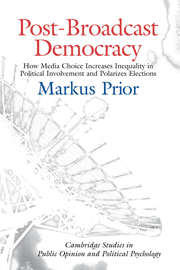 Post-Broadcast Democracy
Post-Broadcast Democracy Book contents
- Frontmatter
- Dedication
- Contents
- List of Tables
- List of Figures
- Acknowledgments
- 1 Introduction
- 2 Conditional Political Learning
- Part I The Participatory Effects of Media Choice
- Part 2 The Political Effects of Media Choice
- 6 Broadcast Television, Partisanship, and the Incumbency Advantage
- 7 Partisan Polarization in the High-Choice Media Environment
- 8 Divided by Choice: Audience Fragmentation and Political Inequality in the Post-Broadcast Media Environment
- References
- Index
- Books in the Series
7 - Partisan Polarization in the High-Choice Media Environment
Published online by Cambridge University Press: 05 July 2014
- Frontmatter
- Dedication
- Contents
- List of Tables
- List of Figures
- Acknowledgments
- 1 Introduction
- 2 Conditional Political Learning
- Part I The Participatory Effects of Media Choice
- Part 2 The Political Effects of Media Choice
- 6 Broadcast Television, Partisanship, and the Incumbency Advantage
- 7 Partisan Polarization in the High-Choice Media Environment
- 8 Divided by Choice: Audience Fragmentation and Political Inequality in the Post-Broadcast Media Environment
- References
- Index
- Books in the Series
Summary
In uncommon unison, many academics, journalists, and pundits of all political leanings have recently declared that America in the early twentyfirst century is more politically polarized than it used to be. Different observers stress polarization at different levels — in Congress, in the media, among activists, in the electorate, or, simply, in the “50—50 nation.” Polarization at its most general describes a combination of increasing differences of opinion between opposing political camps and more consistent opinions within those camps. Allegedly, there are more consistent differences between the Republican Party and the Democratic Party and fewer differences within the two parties. Observers like to deplore this partisan “warfare” for its lack of bipartisan spirit and hostility to compromise. Perhaps more importantly, a polarized political climate threatens to drive away moderates, regardless of whether it is based on “myth” (Fiorina 2004a) or fact.
When it comes to the causes of polarization, experts point to a more ideologically divided Congress, greater influence of increasingly extreme party leadership, and the emergence of Fox News, among other things. Even in the absence of a precise definition of polarization and thorough empirical examination of its causes, the assumption has emerged that its likely roots are found at the elite level. Although changes among political elites might contribute to polarization in the public, the Conditional Political Learning model locates a major cause of polarization elsewhere.
Compositional changes caused by moving to the high-choice media environment can polarize elections all by themselves.
- Type
- Chapter
- Information
- Post-Broadcast DemocracyHow Media Choice Increases Inequality in Political Involvement and Polarizes Elections, pp. 214 - 254Publisher: Cambridge University PressPrint publication year: 2007
